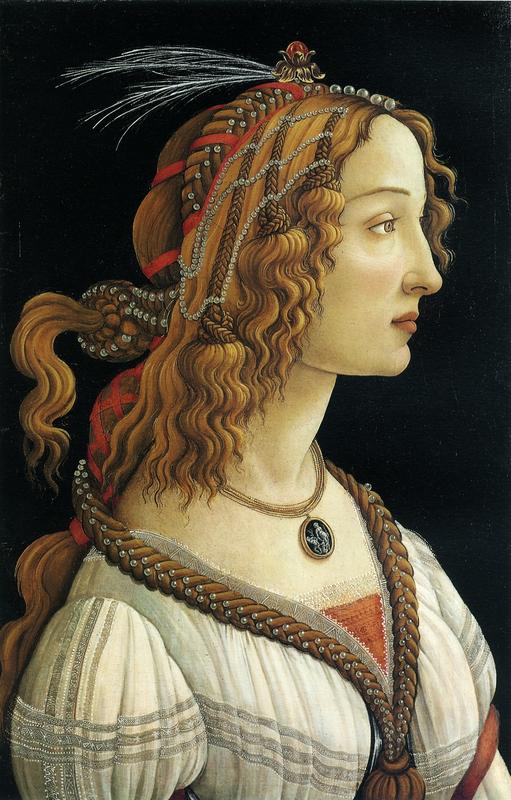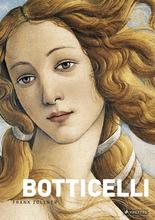More about Idealized Portrait of a Lady
- All
- Info
- Shop

Contributor
Thank God for Sandro Botticelli’s Idealized Portrait of a Lady because there are definitely not enough portraits of idealized women in the world. No, sir.
Another problem with this painting is that this woman, Simonetta Vespucci, definitely did not need idealizing. She was viewed as the most beautiful woman in Europe and pretty much everyone who saw her fell in love with her. She was married to Marco Vespucci by the time she was sixteen years old. She then moved to Florentine court with her husband where she became super popular, catching the eye of all the dudes in Florence. Unfortunately for poor Simonetta, her family used her beauty as a way to attain more social status and wealth. When Simonetta caught the eye of Giuliano de Medici, he made a super public display of affection in the form of a painted banner of her as Athena with the caption that basically said she was the hottest thing anyone had ever seen. Her father-in-law , Piero Vespucci, used this incident to his advantage and basically gave Simonetta to Giuliano de Medici as a lover in exchange for political favors. He was the worst and the a year later Simonetta died of tuberculosis at the age of twenty-three. Simonetta, who by then had an almost cult-like following, had a celebrity funeral. Her open casket was carried through the streets of Florence for everyone to see.
Then it became the hot new thing to paint her posthumously. She may or may not have ever sat for Botticelli while she was alive, but the two had definitely met as she lived on the same street where Botticelli kept his studio. Like in a carved cameo jewel of Ancient Rome, this painting puts Simonetta against a black background (just like the one on her necklace) with her chest slightly turned towards the viewer. There is nothing else in the portrait to distract us from her beauty. She is in the perfect portrait position, because how else are we supposed to gaze on her?
Sources
- Ettle, Ross Brooke. "THE VENUS DILEMMA: NOTES ON BOTTICELLI AND SIMONETTA CATTANEO VESPUCCI." Source: Notes in the History of Art 27, no. 4 (2008): 3-10. http://www.jstor.org.libproxy.newschool.edu/stable/23207901
- "Idealized Portrait Of A Lady (Portrait Of Simonetta Vespucci As Nymph), Ca. 1475." Städel Museum. Web. 24 Oct. 2018. https://www.staedelmuseum.de/en/collection/idealized-portrait-lady-port…
- Jiminez, Jill Berk, and Joanna Banham. Dictionary Of Artists' Models. Routledge, 2001. Web. 24 Oct. 2018. https://books.google.co.uk/books?id=ogFYAQAAQBAJ&pg=PA547#v=onepage&q=s…
Featured Content
Here is what Wikipedia says about Portrait of a Young Woman (Botticelli, Frankfurt)
Portrait of a Young Woman is a painting attributed to the Italian Renaissance painter Sandro Botticelli, who is thought to have executed it between 1480 and 1485, although some authorities attribute authorship to Jacopo da Sellaio.
The woman is shown in profile but with her bust turned in three-quarter view to reveal a cameo medallion she is wearing around her neck. The medallion in the painting is a copy in reverse of "Nero's Seal", a famous antique carnelian representing Apollo and Marsyas, which belonged to Lorenzo de' Medici. Art historian Emanuele Lugli has suggested that the three "tassels" of hair at the center of the painting represents downward flames, symbolising the love that onlookers ought to experience when looking at the portrait since, in the Renaissance it was thought that "hair inflames desire".
The art historian Aby Warburg first suggested the painting was an idealised portrait of Simonetta Vespucci. This challenged a previous interpretation, put forward by German scholars, according to which the painting describes an ideally beautiful young woman mythologised as a nymph or goddess, a view reflected in the title given it by the Städel. It belongs to a group of such paintings by Botticelli or his workshop.
The painting is housed in the Städel Museum of Frankfurt, Germany. Other similar Botticelli paintings are to be found in the National Gallery, London, the Gemäldegalerie, Berlin, and in the Marubeni Collection, Tokyo.
Check out the full Wikipedia article about Portrait of a Young Woman (Botticelli, Frankfurt)















